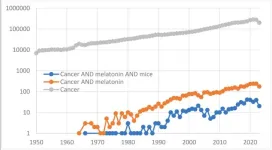(Press-News.org) Not all bacteria are created equal.
Most are single-celled and tiny, a few ten-thousandths of a centimeter long. But bacteria of the Epulopiscium family are large enough to be seen with the naked eye and 1 million times the volume of their better-known cousins, E. coli.
In a study published Dec. 18 in Proceedings of the National Academy of Sciences, researchers from Cornell and Lawrence Berkeley National Laboratory have for the first time described the full genome of one species of the family of giants, which they’ve named Epulopiscium viviparus.
“This incredible giant bacterium is unique and interesting in so many ways: its enormous size, its mode of reproduction, the methods by which it meets its metabolic needs and more,” said Esther Angert, professor of microbiology in the College of Agriculture and Life Sciences, and corresponding author of the study. “Revealing the genomic potential of this organism just kind of blew our minds.”
The first member of the Epulopiscium family was discovered in 1985. All members of the species live symbiotically within the intestinal tracts of certain surgeonfish in tropical marine coral reef environments, such as the Great Barrier Reef and in the Red Sea.
Because of its gargantuan size, scientists initially believed it was some distinct type of protozoan, Angert said. The name Epulopiscium comes from the Latin roots epulo, meaning “a guest,” and piscium, “of a fish.” While most bacteria reproduce by dividing themselves in half to create two offspring, E. viviparus create as many as 12 copies of themselves, which grow inside a parent cell and then get released, “active and swimming – viviparus means ‘live birth,’” Angert said.
Studying these giant bacteria requires capturing the fish in which they live and preserving the cells or extracting DNA and RNA as quickly and carefully as possible, said Angert, who for decades has collaborated with fish biologists at Lizard Island Research Station in Australia to collect and study samples.
The researchers were especially interested to learn how E. viviparus fuels its extreme metabolic needs. Bacteria that feed off nutrients in their environment, rather than creating their own energy from sunlight, generally fall into two camps: those that have access to oxygen and those that don’t. Without oxygen, bacteria often use fermentation to extract energy, and “fermenting organisms just don’t get as much bang for the buck from nutrients,” Angert said.
Seeing that E. viviparus is indeed a fermenter just made the puzzle larger, as its huge size, extreme reproduction and ability to swim would all require more energy, not less.
The researchers discovered that E. viviparus has modified its metabolism to make the most of its environment, by using a rare method to make energy and to move (the same swimming method is used by the bacteria that cause cholera), and by devoting a huge portion of its genetic code to making enzymes that can harvest the nutrients available in its host’s gut. Among the most highly produced enzymes are those used to make ATP, the energy currency of all cells. A highly folded membrane that runs along the outer edge of E. viviparus provides important space for the energy-producing and -transporting proteins, with some surprising similarities to how mitochondria function in the cells of more complex organisms, Angert said.
“We all know that phrase ‘the mitochondria are the powerhouse of the cell,’” Angert said, “and amazingly, these membranes in E. viviparus have kind of converged on the same model as the mitochondria: They have a highly folded membrane that increases surface area where these energy-producing pumps can work, and that increased surface area creates a powerhouse of energy.”
This basic research has a host of potential future applications, particularly as E. viviparus has such effective strategies to make use of the nutrients found in algae, Angert said. Algae is a growing target for livestock feeds, renewable energy and human nutrition, since its growth doesn’t compete with land-based agriculture.
First author of the study is David Sannino, Ph.D. ’17, a former postdoctoral associate in Angert’s lab. Other co-authors are Francine Arroyo, Ph.D. ’19 and former postdoctoral researchers Charles Pepe-Ranney and Wenbo Chen; and Jean-Marie Volland and Nathalie Elisabeth, both with Lawrence Berkeley National Laboratory.
This research was supported by the National Science Foundation and the Department of Energy.
-30-
END
Giant bacterium uses unique processes to power itself
2023-12-18
ELSE PRESS RELEASES FROM THIS DATE:
Quantifying barriers to establishing sequestration wells
2023-12-18
Carbon capture and sequestration (CCS), the process of capturing and storing atmospheric carbon dioxide, is one method of reducing the amount of carbon dioxide in the atmosphere in efforts to reduce the impacts of climate change. While CCS is an essential tool in decarbonizing the U.S. economy, there are barriers that exist to the development, approval, and implementation of a geologic sequestration site, as it requires an appropriate geologic formation, as well as an approved injection facility.
Recent work from the Carnegie Mellon University Department of Engineering and Public Policy (EPP) estimates the time required to develop, approve, and implement ...
Sylvester cancer researcher and technology innovator named fellow of the National Academy of Inventors
2023-12-18
MIAMI, FLORIDA (Dec. 18, 2023) – Shanta Dhar, Ph.D., assistant director of Technology and Innovation at Sylvester Comprehensive Cancer Center at the University of Miami Miller School of Medicine, has been named a fellow of the National Academy of Inventors.
Her research focuses on ways to overcome barriers to precisely target mitochondria – the part of each cell that generates the energy needed for biochemical reactions. Her inventions and innovative contributions in nanomedicine, mitochondria-targeted drug delivery, and platinum-based prodrugs help guide targeted therapies in cancer and other diseases.
Dhar, an associate professor of biochemistry and molecular biology ...
Team led by UMASS Amherst discovers how to sabotage antibiotic-resistant ‘superbugs’
2023-12-18
Antibiotic-resistant “superbugs” that can defeat efforts to kill them are an urgent public health crisis, and according to the Centers for Disease Control, more than 2.8 million antibiotic-resistant infections occur each year. Researchers across the world are scrambling to meet the challenge. A collaborative team of researchers led by the University of Massachusetts Amherst and including scientists from the biopharmaceutical company Microbiotix recently announced that they had successfully learned how to sabotage a key piece of machinery that pathogens use to infect their host cells, and have developed a test to identify the next-generation drugs ...
How effective are opioid medications for cancer pain?
2023-12-18
Researchers examining the data on opioids for pain caused by cancer have found surprisingly large gaps in evidence regarding the true benefits of these medicines for cancer pain. The review challenges the commonly held view that opioids are the most powerful pain relievers.
The University of Sydney-led review highlights there is no ‘one size fits all’ treatment approach for cancer pain, urging health professionals and patients to carefully weigh up the evidence when deciding on a suitable pain management plan.
Opioid pain relievers are the most common treatment for cancer pain management. Many international guidelines including the ...
Firearms and hanging top methods for suicide in US as rates continue to rise
2023-12-18
Embargoed for release until 5:00 p.m. ET on Monday 18 December 2023
Annals of Internal Medicine Tip Sheet
@Annalsofim
Below please find summaries of new articles that will be published in the next issue of Annals of Internal Medicine. The summaries are not intended to substitute for the full articles as a source of information. This information is under strict embargo and by taking it into possession, media representatives are committing to the terms of the embargo not only on their own behalf, but also on behalf of the organization they represent.
----------------------------
1. ...
B cell deficient patients gain protective T cell immunity following SARS-CoV-2 vaccination and infection, study finds
2023-12-18
B cell deficiency is a common condition that can result either from immunosuppressant drugs used to treat autoimmune disease or certain cancers — such as rituximab (RTX) — or from natural immune deficiency. These patients suffer from a weakened immune system that is less effective at combating both viral and bacterial diseases. As B cells are a key type of immune cell that produces antibodies, a deficiency results in a significant decrease in antibody count that can lead to severe disease or death upon infection with SARS-CoV-2.
Researchers at the Ragon Institute of Mass General, MIT, and ...
New guidelines released for practitioners treating anaphylaxis and atopic dermatitis
2023-12-18
ARLINGTON HEIGHTS, Ill. – (December 18, 2023) — Two new practice parameters from the Joint Task Force for Practice Parameters (JTFPP) offer evidence-based recommendations for the diagnosis and management of anaphylaxis and atopic dermatitis (AD) in pediatric and adult patients. The Joint Task Force is a partnership between the American College of Allergy, Asthma and Immunology (ACAAI) and the American Academy of Allergy, Asthma and Immunology.
“Both anaphylaxis and atopic dermatitis are allergic conditions that affect millions of people – in the United States and around the world,” says allergist Jay Lieberman, MD, co-chair of the JTFPP ...
Spike in dermatology visits for skin problems seen during summer of wildfires
2023-12-18
New research suggests that air pollution may contribute to the development or worsening of skin conditions.
The work, which is published in Dermatology and Therapy and led by scientists at Massachusetts General Hospital (MGH), a founding member of the Mass General Brigham healthcare system, points to the need to improve air quality to lower the burden of skin disease, especially for vulnerable communities.
“We were inspired to investigate the relationship between air pollution and skin inflammation after listening to patients who kept telling us that their skin conditions like eczema were particularly bad, and in some cases ‘worse than ever before,’ this summer,” ...
Melatonin and carcinogenesis in mice: The 50th anniversary of relationships
2023-12-18
“[...] murine models proved to be valuable and, in some cases, indispensable for advancing melatonin applications in oncology [...].”
BUFFALO, NY- December 18, 2023 – A new research perspective was published in Oncotarget's Volume 14 on December 12, 2023, entitled, “Melatonin and carcinogenesis in mice: the 50th anniversary of relationships.”
Fifty years ago, in 1973, Vladimir N. Anisimov and coauthors demonstrated for the first time an inhibitory effect of the pineal ...
Yale study finds “Forever chemicals” promote cancer migration
2023-12-18
New Haven, Conn. — In a new study by researchers at the Yale School of Public Health, two “forever chemicals” spurred cancer cells in the lab to migrate to new positions, an indication that the chemicals could contribute to cancer metastasis in living organisms.
The study addressed the group of industrial chemicals called per- and polyfluoroalkyl substances (PFAS). The substances are known as “forever chemicals” because they don’t break down in the environment and can build up in the human body. They have the ability to shed water and resist penetration by oils. They are ...



